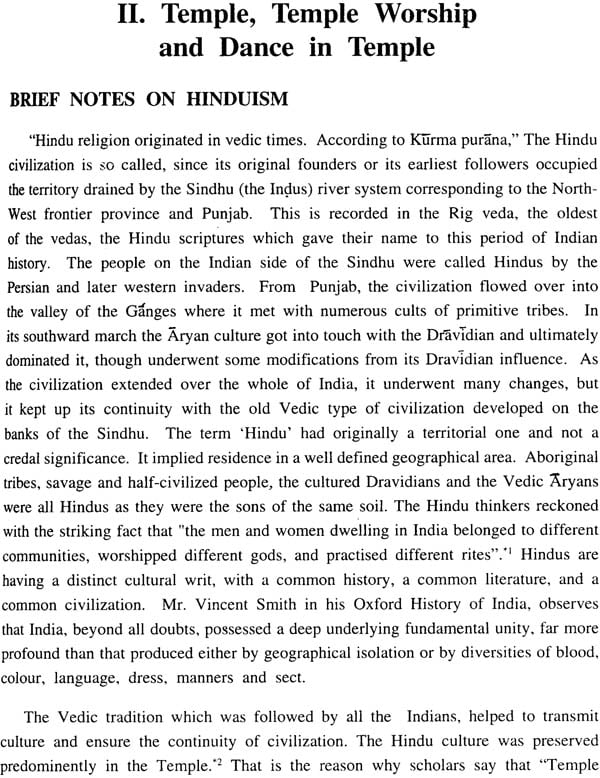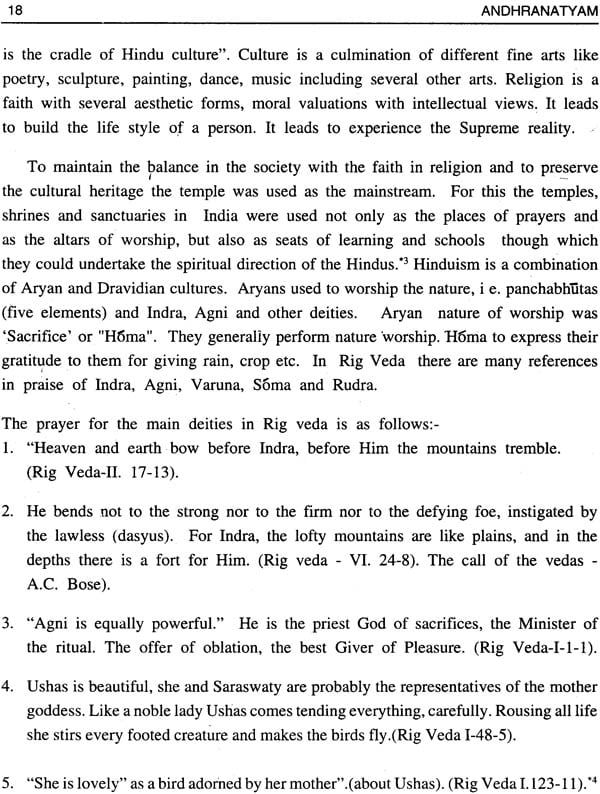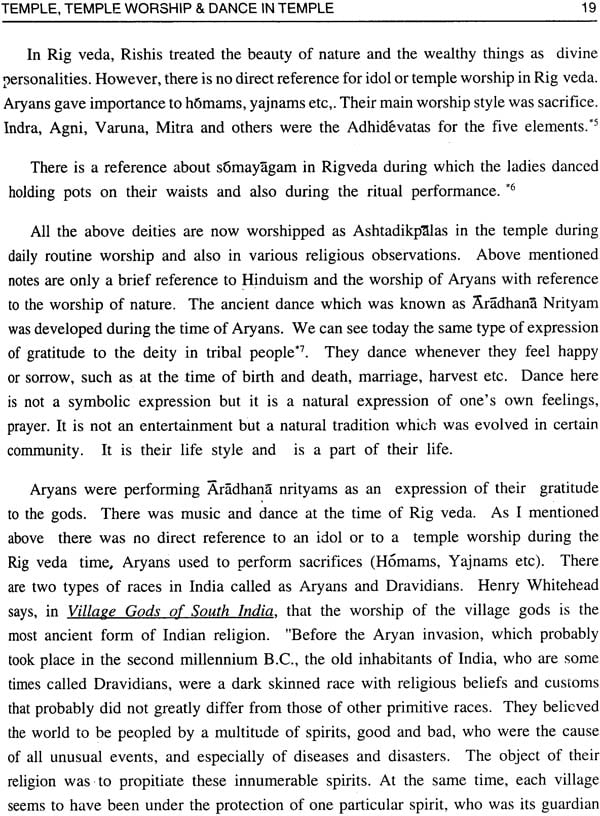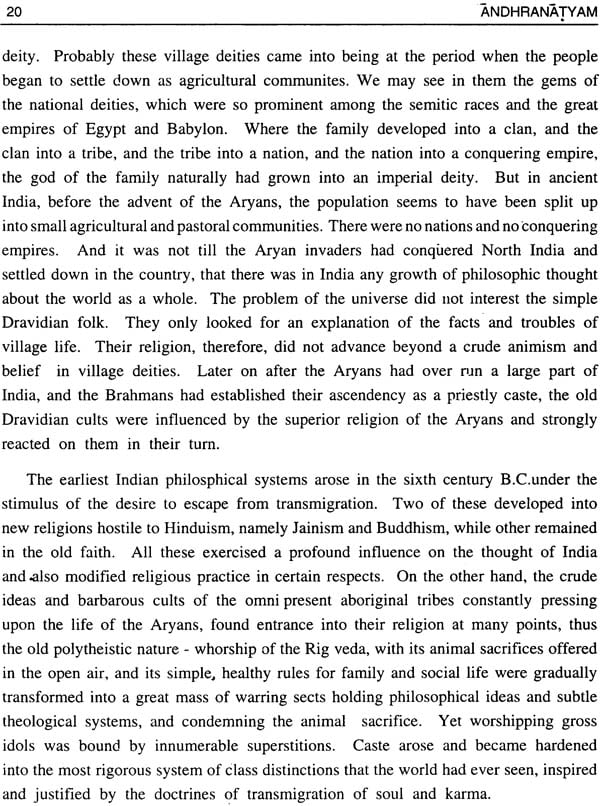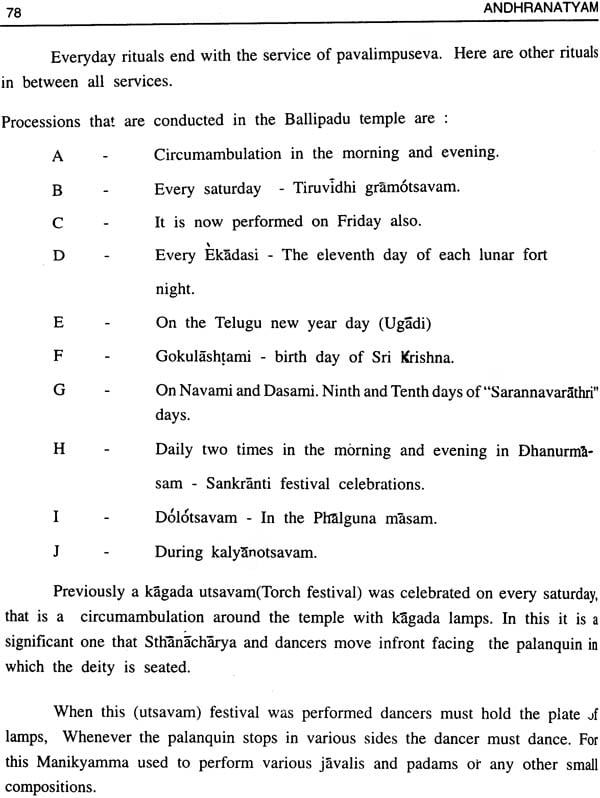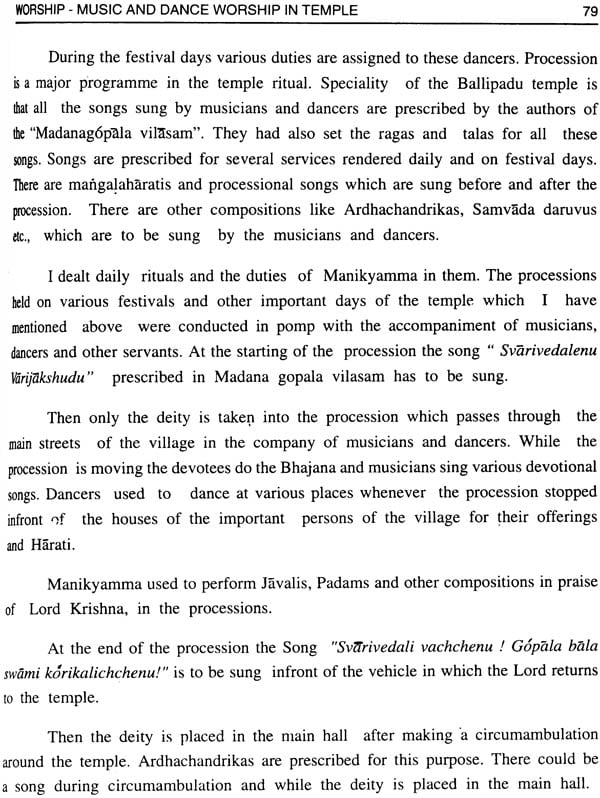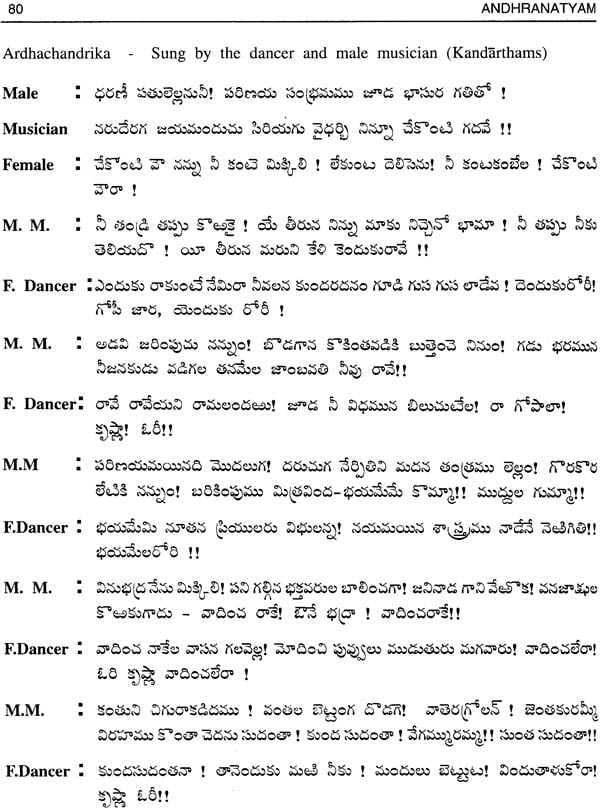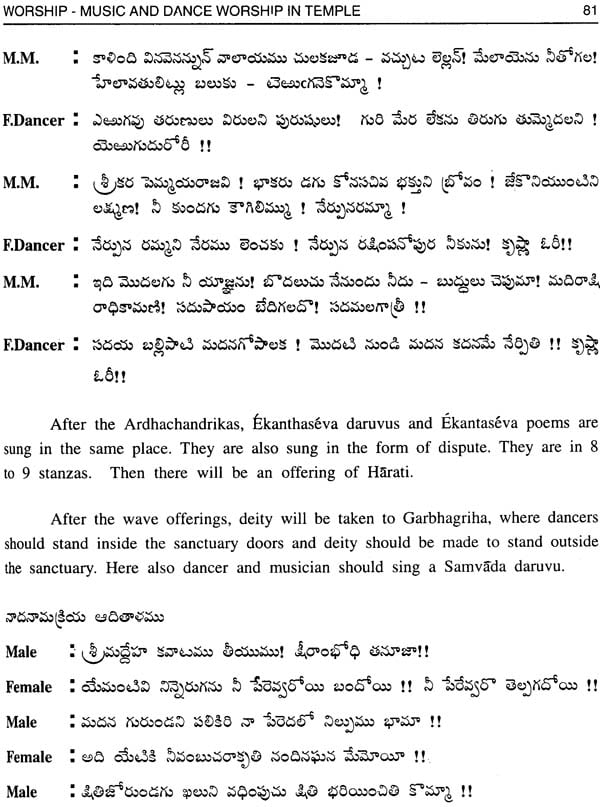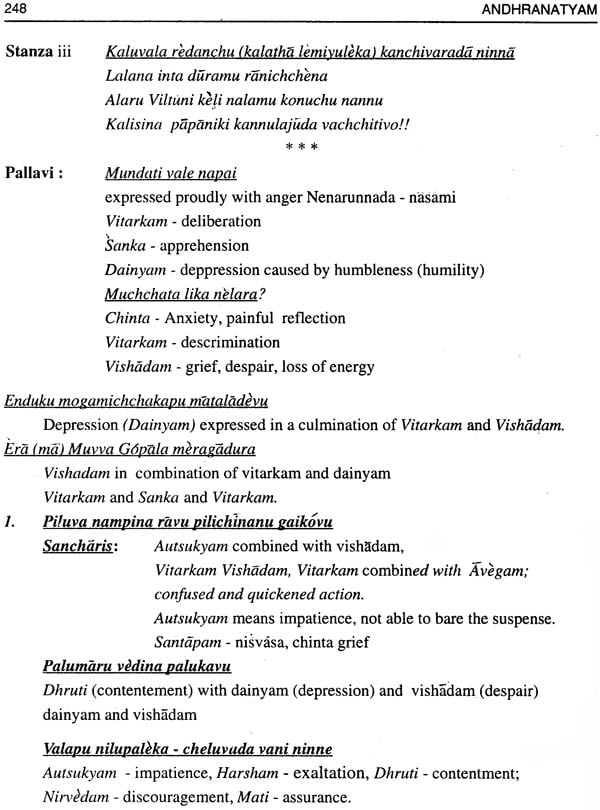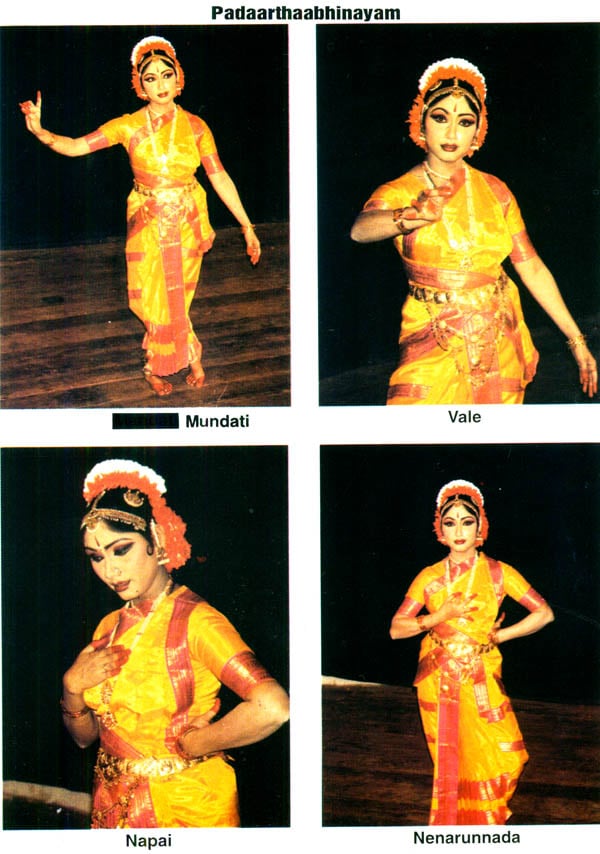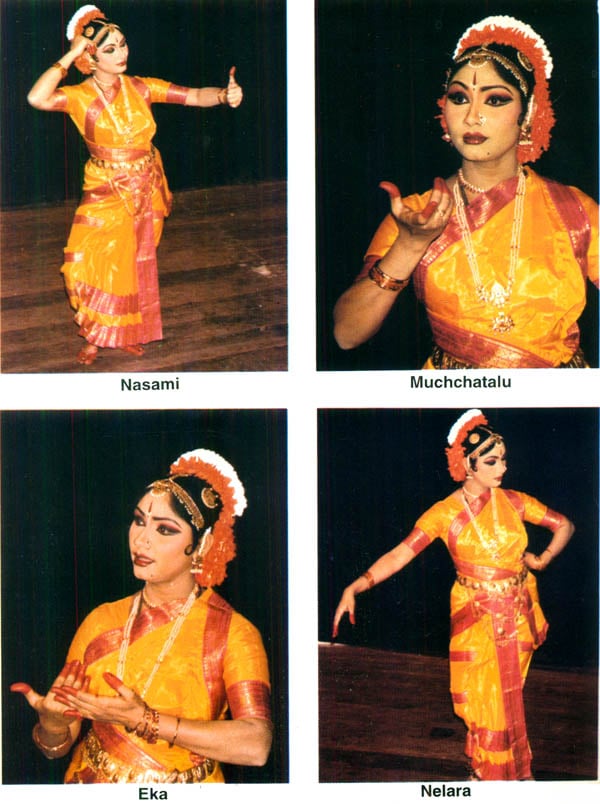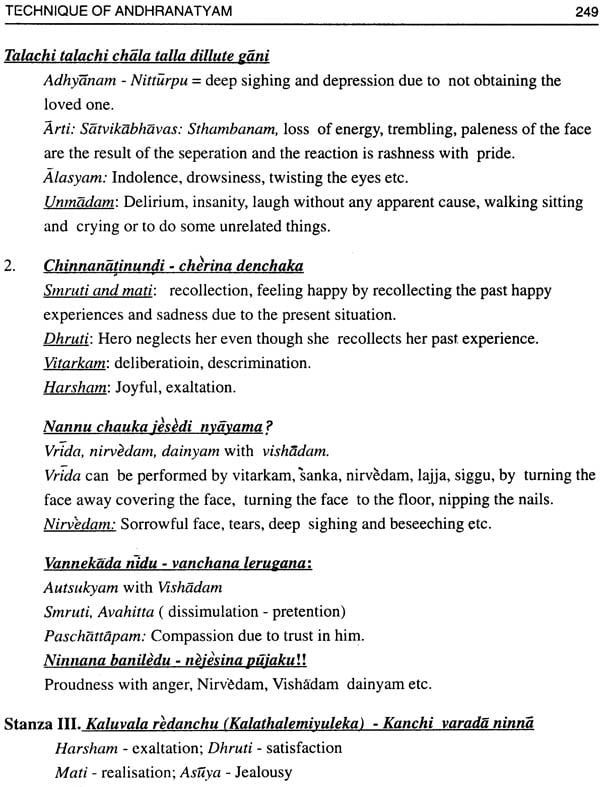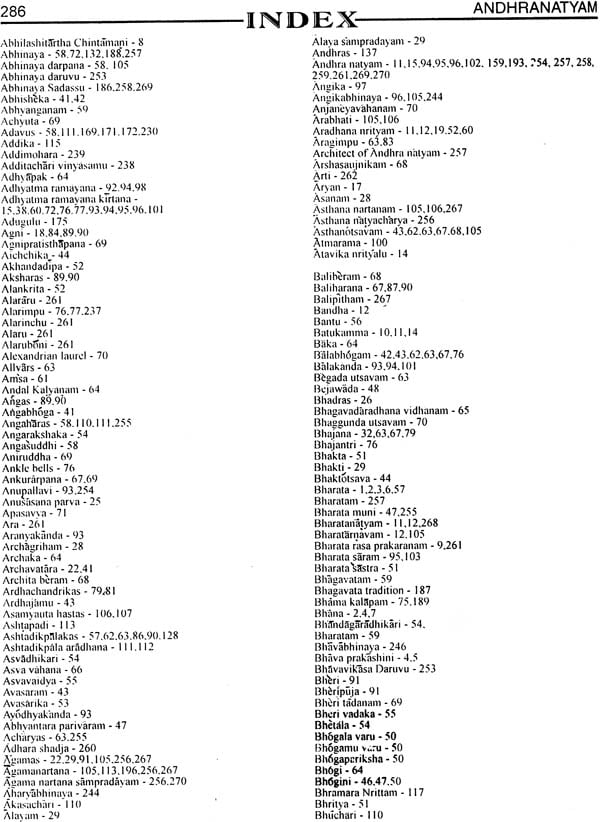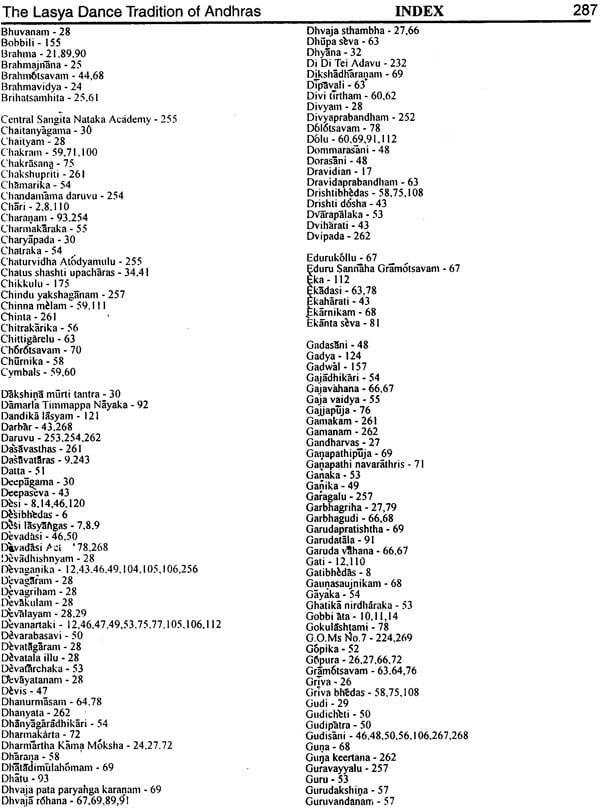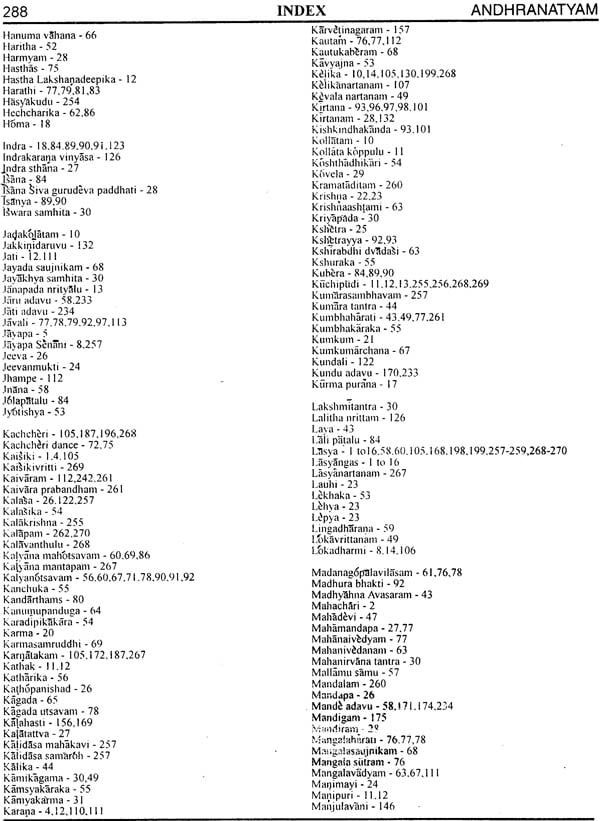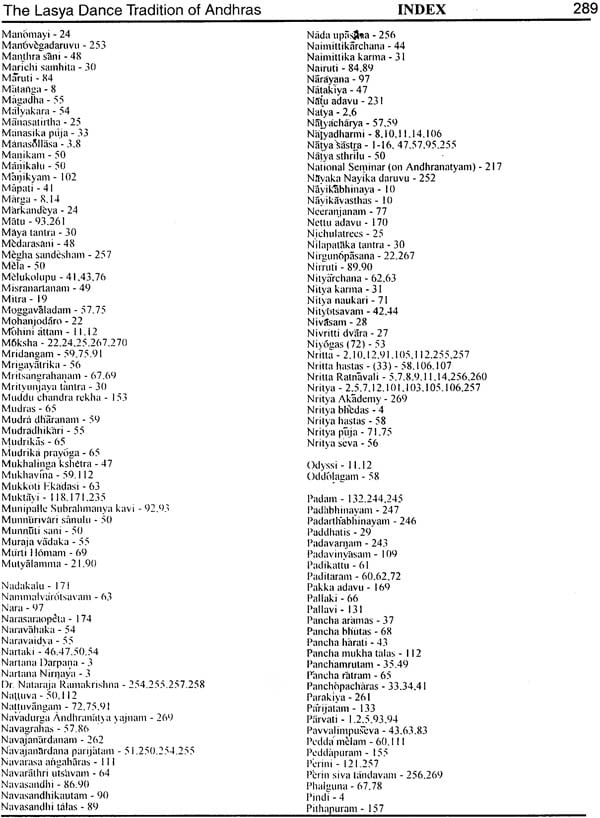
Andhranatyam (The Lasya Dance Tradition of Andhras) - A Rare Book
Book Specification
| Item Code: | NAJ098 |
| Author: | Dr. K.V.L.N. Suvarchala Devi |
| Publisher: | Tirumala Tirupati Devasthanams, Tirupati |
| Language: | English |
| Edition: | 2002 |
| Pages: | 302 (62 B/W and Color Illustrations) |
| Cover: | Paperback |
| Other Details | 9.5 inch x 7.0 inch |
| Weight | 500 gm |
Book Description
About the Author
Dr. Suvarchala Suresh, the author, is an artiste of Andhranatyam tradition. In her early age, she received training in dance from Smt. Saride Manikyamma, at Nritya Kala Nilayam, Jadcharla, Dist. Mahabubnagar. She gave dance performances at various places in Andhrapradesh on many occasions.
Later, she became a disciple of Padmasri Dr. Nataraja Ramakrishna, under whose scholarly guidance she completed her Master's Degree in Performing Arts (Dance) in 1991 as well as successfully carried out her research work on "Andhranatyam - The Lasya Dance Tradition of Andhras" and received her Doctorate Degree from the University of Hyderabad in 1997.
Dr. Suvarchala has conducted several seminars and Dance demonstrations for the children interested in the Indian classical dance and running a dance institution: Abhinaya Akademy of Andhranatyam.
She also actively participated in the Andhranatyam seminar at Vijayawada and the National Seminar on Andhranatyam at Hyderabad held in July and September 1994 respectively.
Her articles on Dance art have been published in various literary magazines like Rasamayi, Musi and Quarterly Telugu Magzine - NRIs' special Edition from Telugu Akademy, Hyderabad.
She planning to bring new dimensions to the Dance Art with the help of Padmasri Dr. Nataraja Ramakrishna, the only Guru and the authority on all forms of Dance Art in Andhrapradesh.
Foreword
The richness manifest in the Cultural mosaic of India is a concomitant product of the Company's unique receptive and assimilative attribute prevalent through ages. History chronicles successive episodes transforming the Country into a symbol of glory of the concept of unity in diversity. Multiplicity of races, regions, religions, languages, traditions and the like is indeed a boon, in that it operates as a potential instrument for profusion in all arts and allied spheres of creative activity. Underneath the kaleidoscopic plentitude lies the binding force of Indianness, which serves as the bedrock for the organic unity.
If we look at the panorama of Indian dance, we will be surprised at the large number of classical traditions, which phenomenon is not found in any other country of the World. We have Bharatha Natyam, Kathak, Kuchipudi, Kathakali, Manipuri, Odissi, Mohiniattam etc. on the classical side which have won international acclaim and innumerable forms under folk and tribal category, which equally received accolades. Andhra Pradesh occupies the pride of place so far as classical dances re-concerned, because of the presence of Perini and Andhra Natyam as classical dances originated and prospered here, besides Kuchipudi one of the most outstanding classical dance traditions at global level. Though there are some common factors, the three classical styles have their own theories, norms and principles to establish their individual identity and classicism, as an integral part of dance legacy of India.
Andhra Natyam, which comes under the Dakshinatya Lasya school, owes its present.status and focus to Dr. Nataraja Ramakrishna, a distinguished exponent of dance for his relentless efforts to revive the form and give it an academic fortification.
The author of this book, Dr. K.V.L.N.Suvarchaladevi is a gifted artiste and a research scholar highly devoted to the cause of propagation of dance. In her 'Andhranatyam', her doctoral thesis, she presents the subject explaining all its facets in great detail. She delves deep into the origin of the practice of dance in temple and deals with the history and technique of Andhranatyam with clarity, quoting authoritative texts as well as experiences of Smt. Saride Manikyamma, an eminent temple dancer. The analysis and treatment of the subject are quite admirable.
I congratulate Dr. Suvarchaladevi on her tremendous endeavours in bringing out this useful work.
Preface
"Nrityam darsayami"-this chant is rendered in daily worship of a house holder and also In temples. The shodasopacharas, chatushshashti upachara performed in the worship of an idol(God/Goddess) in the temple had music and dance as compulsory offering. Music and Dance were prescribed a a part of ritual performance in the Agama sastras. In the Vaikhanasa Agama there is a mention of nine fold worship of God. In this, Maricha maharshi mentioned the nine fold worship i.e., Uttama Uttama, Uttama Madhyama, Uttama Adhama, Madhyama Uttama, Madhyama Madhyama, Madhyama Adharna, Adhama Uttama, Adhama Madhyama, Adhama Adhama, with several offerings including dance and music. Worship without dance and music was believed to be a sin. Above chant "Nrityam darsayami" made me to ponder about the importance of dance in the rituals.
Dance developed in two main streams i.e., Lasya and Tandava. They again developed as Nritta, Nritya and Natya. In Andhra Pradesh, classical dance art developed in the temple, in the court and in the open arena. Temple dance and court dance were mainly practised by the female artistes. These dances were described in the Telugu literature from 11th century to 17th century. As an offering in the temple the dance was patronised in a great grandeur by the king and the society. Gudisani in Andhra Country attained a great admiration and social status.
In the course of my research work I came to know that the Lasya dancers in Andhra Pradesh were named as Venkataratnam, Venkatanarayana, Nukaraju, etc. which sounded like male names. I asked my Guru Dr. Nataraja Ramakrishna about this. He explained the gradual degradation of the status of dancers in the society. Temple dancers were not known as 'Devadasis' in Andhra. They were called as Gudisanis, Devaganikas, Devanartakis, Gudichetis. Dasis were the slaves who used to be with the queens in the harems most of the dasis were sent with the queens as a matrimonial gift 'Aranam' from their mother's home. Their names were generally Mandaramala Kamalanetri, Sarasiruham, Vasanthalathika, etc. Some of the scholars who did not know the fact were confused and believed that names like Venkataratnam, Ramabhadram, etc. were the names of Kuchipudi dance maters. But most of the female dancers of 20th century were known with male gender names. The reason is the degradatory, status of dancers and the people who wanted to use them in other ways but not as artistes and used to call them as Manikyam, Mutyam, etc. Instead of calling Manikyamma they called as Manikyam. They deliberately avoided the suffix "Amma".
Once temple dancers were believed to be Nityasumangalis and were invited to the marriage ceremonies of the higher families. They used to sing the mangala haratis and used to give some black beeds (Neelalohita) from their chain to the bride, which was believed to be very . auspicious and the bride would be blessed by God as a "Sumangali"
In the beginning of the 20th century the dance practice was a taboo in India. Almost all the female dancers have stopped dance performance in Andhra Pradesh.
The present study on Andhranatyam as the Lasya dance tradition of Andhras has endeavoured to make the readers understand various aspects in relation to temple organisation, the socio-economical status of a devanartaki, temple rituals and importance of dance' and music in ritual performance, epigraphical, literary and sculptural evidences and its resurrection in 1970's and also the present technique with a brief repertoire.
No work can be completed without the guidance, help and cooperation of scholars, dance Gurus and friends. I have been fortunate to have direct experience of training from my first Guru Smt. Saride Manikyamma, a former temple dancer, and an eminent artiste of Adhyatma Ramayana Kirtanas Abhinaya, without her help the chapter III would have been incomplete. I have been fortunate to be it direct disciple of Padmasri Dr. Nataraja Ramakrishna who spared his precious time in discussions about various aspects of the dance traditions of Andhra, particularly the evolution of dance in the temple, its spirituality and technique. He, who made me understand the depth of the dance art with his splendourous lecture-demonstrations and training of practical aspects like Adavus, Nritta Nritya and most important aspect Suddha Satvikabhinaya. Words fail to express my heart felt gratitude to Dr. Nataraja Ramakrishna, I owe sincere regards to him for his encouragement and kindness.
I owe my deep sense of gratitude to Sri B.N. Sastry (A famous epigraphist) for extending his help in giving me suggestions and also for providing me with rare inscriptions, books, etc. I am indebted to Sri Gidugu Ramamurthy who helped me in discussing the subject of my research, and correcting my draft. I take this opportunity to record my gratitude to Dr. Arudra, Dr. PSR Apparao, Smt. Chitra Chandrasekharan, Mrs. Sheran Lowren for their help to understand the art of dance by their lectures during my M.P.A. course in the University of Hyderabad.
Particularly I was tremendously benefitted by the discussions with Smt. Annabattula Satyabhama, Smt. Annabattula Lakshmi Mangatayaru, Smt. Annabattula Venkata Narayanamma, Kum. Lakshmi Prasanna, Siddhabattuni Bhramaramba and other traditional artistes who attended the two conferences of Andhranatyam in 1994. My special thanks to Sri Kalakrishna a famous artiste of Andhranatyam, who encouraged me by discussing the subject during research.
I thank the University of Hyderabad, particulary the Sarojini Naidu School of Performing Arts, Fine Arts, Theatre arts and Communications for giving me the Doctorate Degree to the present study.
I owe my gratitude to Sri Pemmaraju Bapiraju and Sri Pemmaraju Hanumantharao for their kind help during my field work at Ballipadu.
I thank all the authorities and staff of various libraries and institutions for their kind co- operation.
My special gratitude to my father Kasi Bhaskara Moorthy, who's help is invaluable in printing the book.
Last but not the least, my special gratitude is due to all the members of my family particularly to my in-laws, Sri P. Narasimha Sarma and Smt. Bharati Sarma for their untiring sacrifices and affectionate blessings. I also acknowledge thanks to my mother K., Sarada devi, brothers Bhargava and Viswarnbhara.
This would be incomplete if I do not acknowledge the timely co-operation of my daughter Sai Satwika and my son Sai Abhinay.
It's my pleasure to acknowledge my hearty gratitudes to my soul i.e., to my husband Penna Suresh for his- encouragement at every step of my project.
I thank, the Telugu University for providing me the financial aid in bringing my thesis in this form. I am obliged to Acharya Gopi the Vice-Chancellor for Telugu University, Hyderabad for blessing me with his kind foreword.
I would like to thank all my friends who encouraged me in every respect and in particular I owe my thanks to Suneela, Perini Prakash, Rajini Vijay, Perini Srinivas and Smt. Sarada Ramakrishna of Vijayawada for her great help during my research work.
I owe my gratitude to the .authors of all the books which I have referred for my research work.
It would be incomplete if I do not extend my thanks to M/s. Vasantha Graphics and Sri Sai Process, Hyderabad without whose dedicated help this would not have reached the readers.
Contents
| I. | A General Introduction to Lasya and Dance Traditions | 1-16 |
| II. | Temple - Temple Worship and Dance in Temple | 17-40 |
| III. | Worship - Music and Dance Worship in Temple Part - I | 41 -102 |
| Temple Ritual Dances for Spiritualization Part-11 | 103-136 | |
| IV. | History of Andhranatyam | 137-185 |
| V. | The Resurrection of Andhranatyam | 186-226 |
| VI. | Technique of Andhranatyam | 227-266 |
| VII. | Conclusion | 267-270 |
| Bibliography | 271-279 | |
| The Augmentation of Indian Dance Art | 280-285 |
